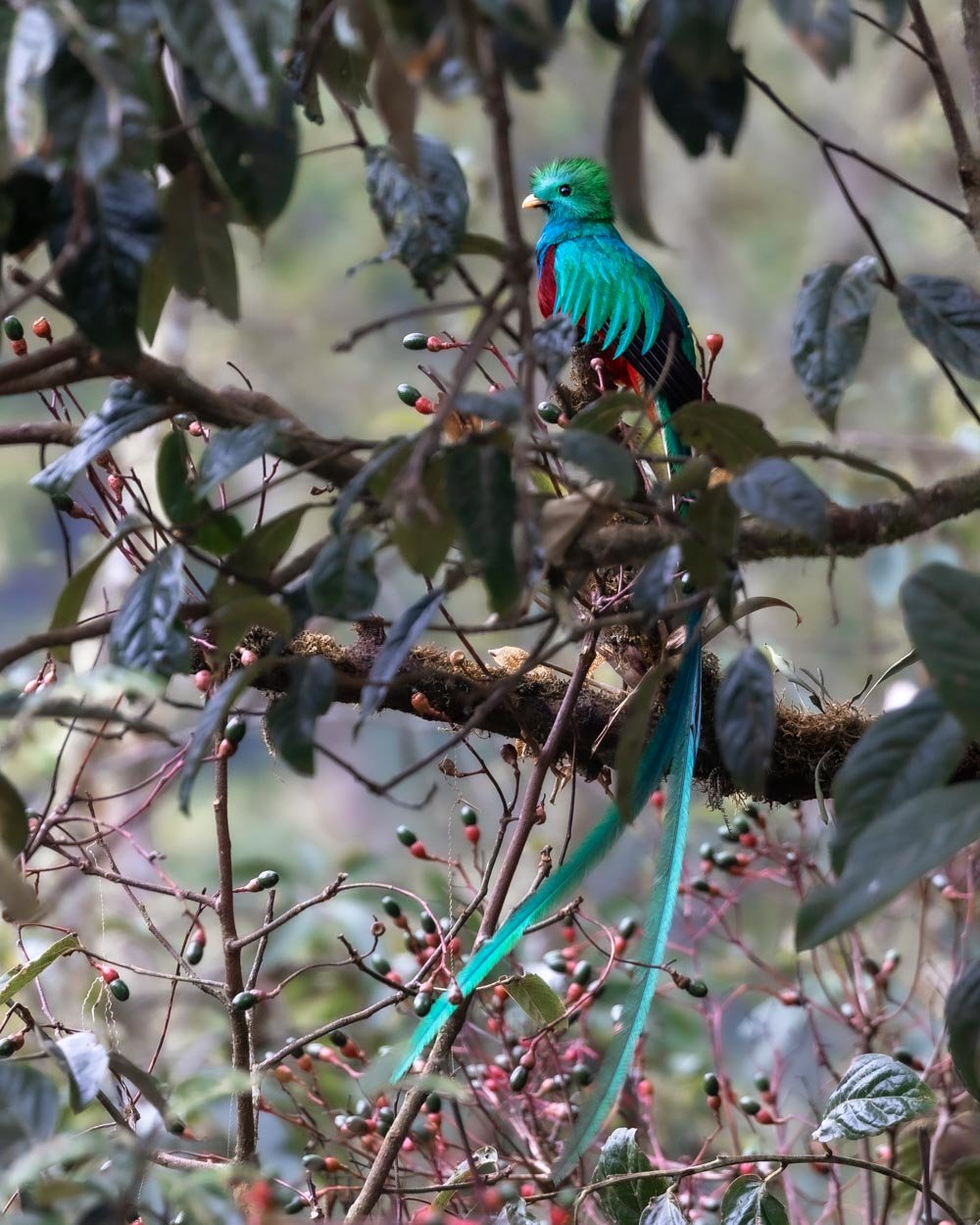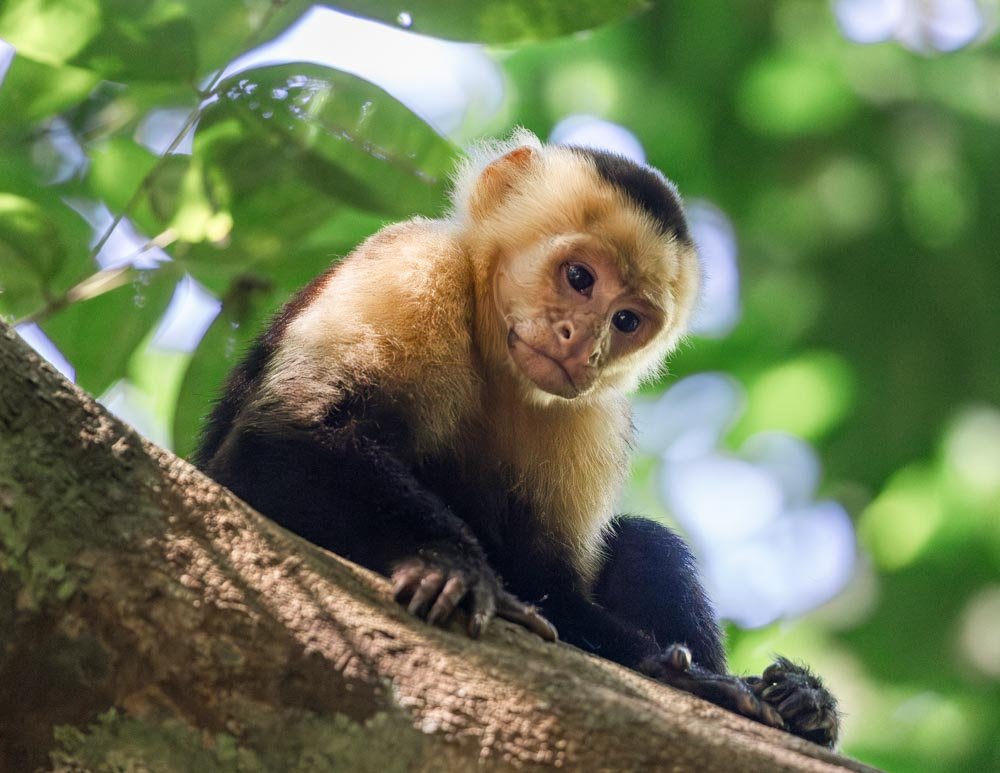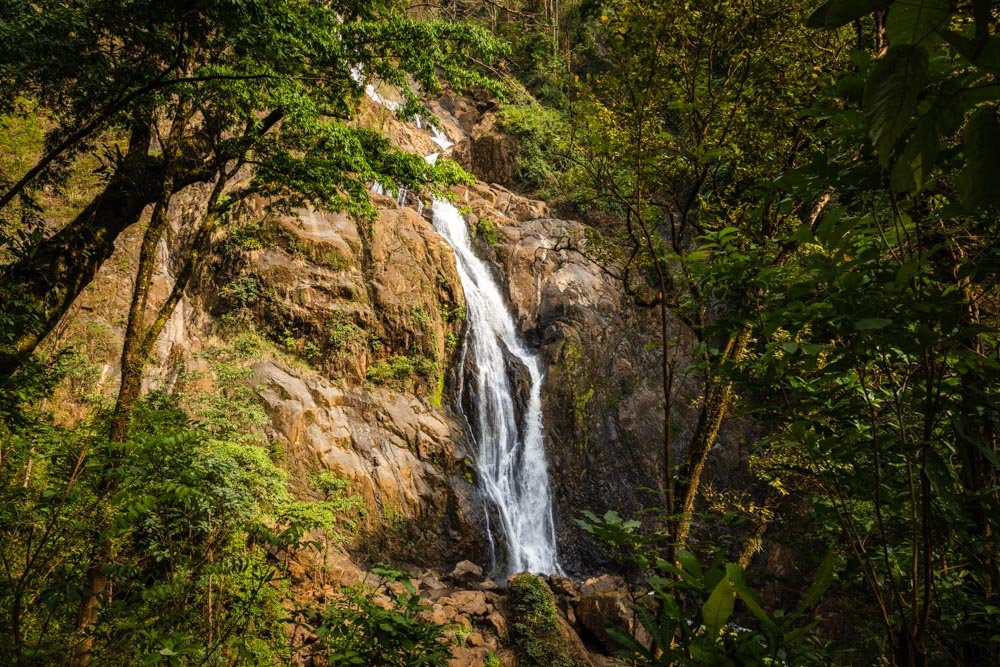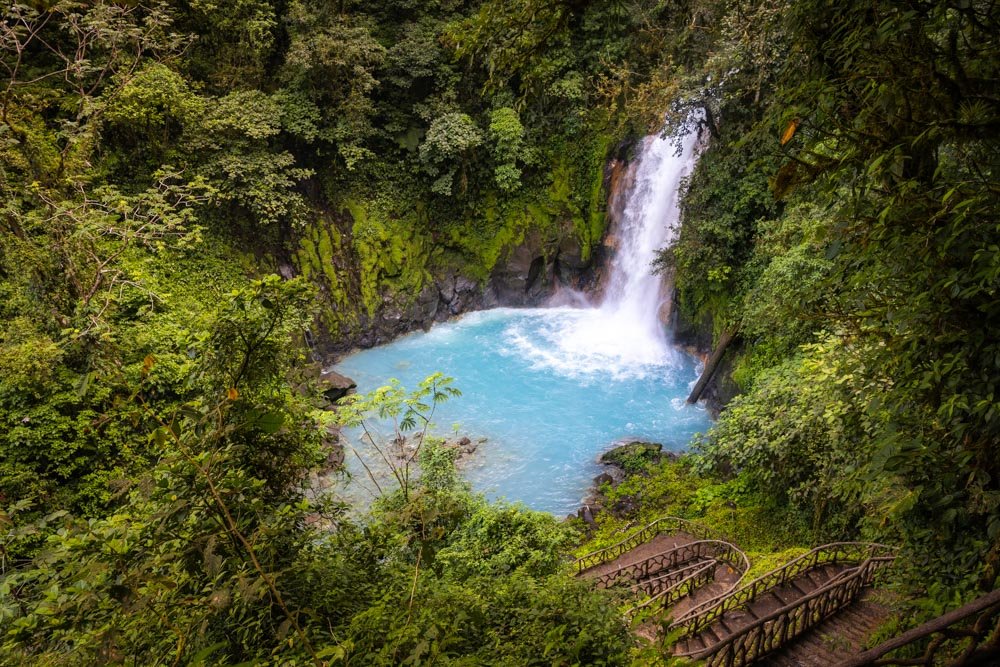One of the most exciting things about a trip to Costa Rica is just how many incredible wildlife watching opportunities there are. We had a big list of animals we were hoping to spot and managed to see almost all of them, from sloths and Howler monkeys to quetzals and Scarlet macaws. Although you will definitely see a variety of wildlife whilst out and about without even trying, if you’re really keen, you’ll probably want to visit some of the spots which offer almost guaranteed sightings.
There’s always a lot of talk about needing a guide to see wildlife in Costa Rica, but that simply isn’t the case. Whilst a guide will almost always find more wildlife than you can alone, you don’t need to have one and we visited all but one of the spots mentioned below independently (and we’re no animal spotting experts!).
In this guide we’re sharing where we spotted various wildlife and how good your chances are in each location.
A quick note on how we put this guide together
We’re sharing the places we found wildlife easily in Costa Rica, as we prefer to talk from personal experience. It’s definitely not to say that you can’t find wildlife outside these areas. The glaring omission from this guide is Corcovado National Park, arguably the best place of all to see Costa Rican wildlife.
The reason for this was simply down to budget. All trips into this particular national park require a mandatory guide and as we wanted to stay overnight - which is when you’ll see the most wildlife - it was prohibitively expensive. No doubt we’ll be back to do it one day.
What it does mean is that all the areas covered in this guide are able to be visited for free or very cheaply - generally for the cost of a national park entry fee.
An overview on the best places to visit for wildlife watching
There are three places that should be top of your list: Corcovado National Park (if budget allows), Tortuguero National Park and Manuel Antonio National Park. All three parks are packed with incredible wildlife spotting opportunities and you’ll see almost all of the iconic Costa Rican animals.
However, the great thing about Costa Rica is that there is amazing wildlife right across the country, so you can visit somewhere like La Fortuna for Arenal Volcano, but also see sloths, and Jaco for the beaches, but also see Scarlet macaws.
Where to find Costa Rica’s Wildlife
Sloths (el perezoso in Spanish)
Area: La Fortuna, Manuel Antonio
Chances of spotting them: Very high
Two types of sloth live in Costa Rica: the two toed and the three toed sloth. We saw both, but the three toed sloths were much easier to see and we saw more than 15 of them, versus 1 two toed sloth.
Whilst we saw many sloths in various areas, we saw the highest numbers of sloths in La Fortuna and Manuel Antonio.
Starting with La Fortuna, we found an amazing free reserve just outside of town where you can see three toed sloths, though sadly since publishing our guide they’ve closed some of it off. However, there is still a section open worth looking at.
We also spotted a sloth on the road into the reserve, which is not uncommon.
If you don’t get lucky, or want to do one of the designated sloth watching trails, you are almost guaranteed to see one on the Bogarin Trail, even without a guide.
We saw three sloths and the walk was both very easy, pretty and shady - a winning combination! You can read how to improve your sloth watching chances in this guide.
In Manuel Antonio we found sloths along three different trails inside the national park. We spotted one on the Mirador Trail and one on the Sloth Trail (which incidentally isn’t the easiest place to see them!) but we found the highest number of sloths on the Official Road Trail.
The official road is basically a fire trail through the park and cars do not use it, so though it’s the least scenic trail in the park, it’s by no means unpleasant. And it’s undoubtedly where you’ll find more wildlife than anywhere else.
We saw sloths a plenty and even caught some moving around, which is far less common. It was an absolute delight. We recommend buying the first possible entry into the park, as this is when the animals will be most active.
Here’s more details on wildlife watching in Manuel Antonio without a guide.
White-faced Capuchin monkeys (Carita Blanca in Spanish)
Area: Rincon de la Vieja National Park, Manuel Antonio
Chances of spotting them: Very high
White-faced Capuchin monkeys are probably one of the easiest animals to find in Costa Rica, especially if you’re planning on visiting Manuel Antonio National Park.
I lost count of how many we saw in Manuel Antonio alone. The most reliable place to spot them is definitely in the trees behind Manuel Antonio Beach.
There were large numbers here and they’re used to people, so will happily go about their business as you look on. We enjoyed watching the group grooming sessions and cheeky antics of some of the babies.
We also saw a huge troop on the trail between Las Gemelas Beach and Escondido Lookout. The trees were teeming with them here and some got so close we had to back away!
Whilst Manuel Antonio would be hard to beat for Capuchin sightings, we also saw a number on the La Cangreja Waterfall Trail in Rincon de la Vieja National Park.
Crocodiles (Cocodrilo in Spanish)
Area: Jaco
Chances of spotting them: Very high
While there are lots of croc spotting tours available in Costa Rica, if you’re looking for a spot you’re almost guaranteed to see them for free, head to the aptly named Crocodile Bridge on the road north of Jaco.
You can park just before the bridge and walk for a couple of minutes to the pedestrian walkway on the bridge itself. From here you have a birds-eye view into the murky waters below. We saw at least seven crocs here, some swimming stealthily through the water and some basking in the sunshine on the river banks.
We also saw a croc on the public boat ride into Tortuguero Village, but the Crocodile Bridge is by far your best bet.
Resplendent quetzal
Area: San Gerardo de Dota, Monteverde
Chances of spotting them: High during nesting season
We spotted our first quetzal within five minutes of entering the Monteverde Cloud Forest, but honestly that was just luck. A visitor had already spotted him so they showed us where to look. Without that help I think you probably need a guide to spot one in Monteverde as the forest is dense.
We met a family who had seen five with their guide earlier that morning. Although I should also mention we hiked in the cloud forest in the afternoon, so maybe there’s a chance we’d have seen one early in the morning, but nowhere near as good a chance as spot number two, San Gerardo de Dota.
San Gerardo de Dota is the place to head if you’re after that coveted quetzal sighting. We visited in March and saw four without a guide and across numerous different days. We even saw one from a cafe terrace when eating lunch, which just about made our whole trip!
We’re no quetzal experts, but nesting season is said to be February to June, although we were told March and April is prime time. Outside of this you might need to hire a guide to find them, however, not all guided tours are created equal.
Most go along the road in the village rather than into the forest, so it may not be the wildlife encounter you were hoping for, you can read more on that in our San Gerardo de Dota guide.
Howler monkeys (Mono congo in Spanish)
Area: Tortuguero, Liberia, Manuel Antonio
Chances of spotting them: Very high
We heard the unmistakable sound of Howler monkeys all over Costa Rica and it quickly became our favourite alarm call. However, there were a few spots that were particularly good for sightings.
Every morning and evening in Tortuguero came with a Howler monkey chorus and it was easy to spot them when kayaking on the river (which is wildlife spotting paradise), on the first part of the The Jaguar Trail (the densely forested section) and along most of the The Rainforest Path on the Cerro Tortuguero Trail.
Liberia is also home to large numbers of Howler monkeys, which we even heard from our accommodation, which was practically in the city centre!
However, it was in the trees by the beach at Llanos de Cortes Waterfall and the trees beside Canon y Catarata at Poza Los Coyotes that gave us our most atmospheric sightings.
Another excellent place to see them is on the jungle path to Biesanz Beach in Manuel Antonio (it’s not inside the national park, so you can visit anytime).
We’d recommend visiting close to sunset when they are at their most active and their roars will accompany you on the 10 minute walk to the beach.
Toucans
Area: Tortuguero, La Fortuna
Chances of spotting them: Very high
We saw dozens of toucans in many locations across Costa Rica, including the most common Yellow throated toucan and the rarer Keel-billed and Acari toucans. You’ll very likely see them fly overhead in places like Tortuguero and La Fortuna, but if you don’t get lucky we have a cheats version.
The staff at the Bogarin Trail in La Fortuna have various feeders out which attract a number of different birds, including toucans. It doesn’t feel as exciting as seeing them in the trees or gliding overhead, but you can almost always see at least one in the car park beside the Bogarin Trail.
Obviously if you’re planning to walk the trail, you’ll see them inside too, but if not, head to the car park and you should be in luck.
Spider monkeys (Mono araña in Spanish)
Area: Rincon de la Vieja National Park, Tortuguero, Drake Bay
Chances of spotting them: Very high
The La Cangreja Waterfall in Rincon de la Vieja National Park gave us the best monkey spotting experience of our entire trip.
We saw three separate troops of Spider monkeys and in huge numbers. Despite the fact we were walking in the middle of a scorching day they were incredibly active.
They were swinging through the trees and making a huge amount of noise, but more memorably than that, they took offence to us walking through their territory.
They shook their fists and threw branches at us as we passed by, which was both funny and a touch alarming at the same time. The waterfall along this trail was beautiful, but it’s the monkeys I will always remember.
Outside of Liberia, we also saw them when kayaking in Tortuguero and from the public boat from the mainland to the village. We saw a big group on the Drake Trail, but I wouldn’t say this is necessarily the best place to see them as we had taken a slight wrong turn at that point, though we describe where they were in the post linked above.
Caiman
Area: Tortuguero
Chances of spotting them: Very high
We’ve explored the waterways of Tortuguero twice now, once alone and once with a guide and both times we saw several caiman. We also spotted them on the public boat to the village (you’re probably noticing a theme here, the public ferry is basically like a wildlife watching cruise!).
On both trips, the caiman were a little further into the national park (rather than on the big open river section that you start the boat journeys on).
They tended to be in the smaller tributaries just before Caño Harold. You can read more about caiman spotting and other wildlife we saw whilst out on the water in Tortuguero in this guide.
Scarlet macaws (Lapa Rojo in Spanish)
Area: Drake Bay, Jaco, Carara National Park
Chances of spotting them: Very high
We saw more macaws (8) than humans (2) on the Bijagual Falls trail, just outside of Jaco. The walk itself is along one of the more rustic trails in Costa Rica and takes you to the bottom of the tallest waterfall in the country.
For those that don’t like the sound of the trail, it might be worth driving up to the trailhead (details in the post linked above) and having a look from the viewpoint next to the entry point where you buy your trail tickets. We saw three from here! We also saw four Scarlet macaws simply flying over the town centre.
If you’re lucky enough to make it to Drake Bay, you will likely encounter many Scarlet macaws. We saw them regularly fly over the town and there was a nest we passed everyday as we walked from our accommodation to the town.
However, the highest numbers we saw were along the Drake Trail. We have a whole article dedicated to finding Scarlet macaws in Costa Rica, which you can read here.
Poison dart frogs
Area: Manuel Antonio, Bijagua
Chances of spotting them: Very high
We’ll start with where we found some ourselves without a guide, which was on the Waterfall Trail in Manuel Antonio National Park. They are very small, but as the trail is really quiet, we could hear rustles in the leaves and spot them easily.
We were lucky enough to see three and I doubt it was a fluke because there were signs up along the trail mentioning spotting frogs and other reptiles.
However, the frogs we wanted to see most were the Blue jeans frog and the Tree frog. Both of these eluded us, so we decided to book onto a night tour that specialises in frogs in Bijagua (approx 1.5 hours from La Fortuna).
Despite visiting when it was very dry (a terrible time to look for frogs) we saw six different species, including three Blue jeans frogs and 10 Tree frogs.
We also spotted a huge array of other wildlife which you can read about here. The tour is a bit off the beaten track, so it’s really quiet and worth every penny (not that it’s particularly expensive!).
Coatis
Area: La Fortuna, Drake Bay
Chances of spotting them: Very high
One of the great delights of our early morning visit to El Choyin (the free hot spring in La Fortuna) was the huge Coati family that entertained us as they went about their morning scavenge.
There were adults and babies and as we were the only ones there, they weren’t fussed by our presence and we could observe them at close range. We also saw them at La Fortuna’s Mistico Hanging Bridges, but I am not sure how common this is.
We saw several different smaller groups of Coatis along the Drake Trail in Drake Bay, which is a brilliant wildlife watching walk in general.
Agoutis
Area: Manuel Antonio National Park, Monteverde, Rincon de la Vieja
Chances of spotting them: Medium
Although we saw agoutis in all the areas mentioned above, there was no one spot that seemed to be good to see them in particular. I’ve seen them in Monteverde on both trips, so that’s probably a good bet. Both times the agouti was in the little forest just beside the car park for Monteverde Coffee Centre (a cafe not far from the Monteverde Cloud Forest).
In Manuel Antonio it was along the Official Road - the amount of times I’ve mentioned the road in this guide probably shows you it is one of the best places in the whole country to see wildlife!
In Rincon de la Vieja, we saw two by the steps leading down to the waterfall on the Las Chorreras Waterfall Trail, but again I think that was pure luck.
Anteaters (Oso Hormiguero in Spanish)
Area: Manuel Antonio National Park, Rincon de la Vieja
Chances of spotting them: Medium
We spotted our first Anteater along the Official Road (it’s a walking trail despite the name) in Manuel Antonio National Park. It was curled up in a tree and wasn’t the best sighting, but we’re told it’s common to see them here in the early morning.
A better sighting, but I think came down to pure luck, was along the Las Chorreras Waterfall Trail in Rincon de la Vieja. It wouldn’t be worth looking for an Anteater here, but if you love blue swimming holes, then come for them and keep an eye out in the forest along the way to the first waterfall.
Great green macaws (Lapa verde in Spanish)
Area: Tortuguero
Chances of spotting them: Very high
Although the Great green macaws can be found in several places on the Caribbean side of Costa Rica, we personally saw many in Tortuguero.
Just five minutes after getting off the boat from the mainland we found them snacking in the trees along the back streets of the village. We saw and heard them daily at our accommodation and saw them fly overhead many times when out kayaking on the river.
There were also four eating almonds on the The Jaguar Trail (El Jaguar terrestrial trail) in the national park, which is right by the village. We saw two different pairs in the trees between the beach and the coastal forest (ie not the dense jungle at the start of the walk). You will no doubt hear them before you see them!
Where to look for the ones we missed out on
Tapir (Danta in Spanish)
This is the one animal that I was desperate to see and despite making a big effort, missed out on. The closest we got was seeing fresh tracks on the Naguala Waterfall Track in Drake Bay. We hoped to spot one on the Drake Trail and specifically booked accommodation that said they regularly came into the garden in the evenings, but alas it was not to be.
Although they can be found in various places across Costa Rica, there’s no doubt that the best place to see them is Corcovado National Park.
Turtles (Tortuga in Spanish)
Sadly, despite the fact we’ve visited Tortuguero twice now, it’s never been in turtle season. Well, it was Leatherback turtle season, but they are almost impossible to spot. You need to visit in the Green turtle nesting season, which is roughly June to October, with peak season being July - September.
They are also said to be common at Isla del Caño (off Drake Bay), which you need a tour to visit and they were sadly very expensive.
There are many other places you can also see turtles in Costa Rica, but you have to be there at the right time of year.
Humpback whales (Ballena jorobada in Spanish)
We visited two of the best places in the whole country to see Humpback whales, but as with the turtles, not in the right season. Drake Bay is said to be an amazing place to see them and they are often spotted on the boat ride over from the mainland, or on the boat ride between Drake Bay and Corcovado National Park. The season is mid July to October and again between November and April. So our visit in May was one of the few months where you can’t see them!
The other place would be Uvita and they are often spotted on the easy Whale Tail Walk in the national park just outside Uvita town. The season is said to be December to April and mid July to mid October, so again our May visit was one of the few months they can’t be spotted!
Tips for wildlife spotting in Costa Rica
Generally wildlife in Costa Rica is most active at dawn and dusk, so early starts and later finishes can really pay off. It’s much easier to spot wildlife when they are moving around, so though you definitely can spot animals during the day, it’s easier earlier or later in the day.
Some of Costa Rica’s wildlife is nocturnal (for example 80% of the wildlife that lives in Monteverde Cloud Forest is nocturnal) which is why night tours are so popular. We’re not fans of tours, but would recommend you take one night tour whilst in Costa Rica. We did try our hand at spotlighting without a guide, but we weren’t very good at it. We ended up taking two night tours and our favourite by far was Frog’s Paradise, around 1.5 hours from La Fortuna.
Don’t get too close! Even if the animals come close to you, it’s best to move back. The monkeys might look cute, but they could bite or go for your backpack! It goes without saying not to feed them.
Always look high into the tree tops when searching for animals like sloths. They can often be right above your head, but if you never look to the top of the canopy you won’t spot them.
This post may contain affiliate links, meaning at no additional cost to you, we will earn a small commission if you click through and decide to make a purchase. This helps towards the costs of running our website. Thanks for your support.


























































